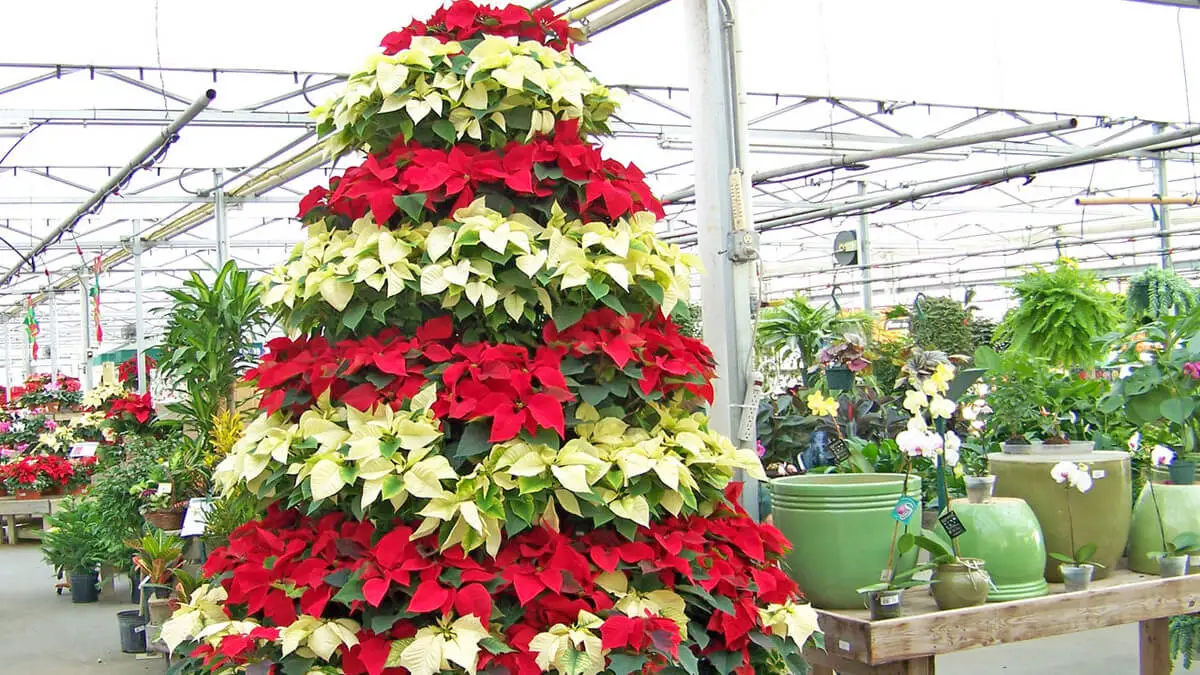How to Grow a Poinsettia Tree
The species of poinsettia tree belong to the Euphorbiaceae family. This tree has a high commercial value. It is native to central American Lands. Experts described this tree as a new species in 1834.
This article focuses on the poinsettia tree, its characteristics, propagation, caring, and uses.
In fact, the poinsettia tree is named after the first US minister to Mexico, Joel Roberts Poinsett. He introduced this tree to the United States in the early 1820s.
These trees, in their wild form widely grow across Mexico to Guatemala. There is a specific poinsettia variety growing in Guerrero (Mexico). Most people believe this variety to be the ancestor of most of the present cultivated forms. However, these wild varieties face high fragmentation due to unregulated deforestation.
The Mexican Aztecs (1300 to 1521) used these trees in their traditional medicine. In modern days, the US consumes more than 70 million poinsettias Every year. Ecke family grows these trees as an industry. They serve over 70% of the poinsettia market in the USA and about 50% of the same in the world.
Generally, these are small trees or shrubs that grow about 2.0–13.1 ft (0.6 to 4 meters). These trees are popular for their fascinating green and red combination foliage. Usually, the Poinsettia tree is used in floral displays, particularly during Christmas.
Some people consider these trees to be toxic. But they are not as dangerous as known toxic trees. For Example, coral trees, wax trees Etc., are known for their toxicity. Most of the time, even the consumption of poinsettia has no harmful effects. However, their consumption may lead to vomiting, diarrhea, or nausea in some cases.
Table of Contents
Poinsettia Tree in the USA
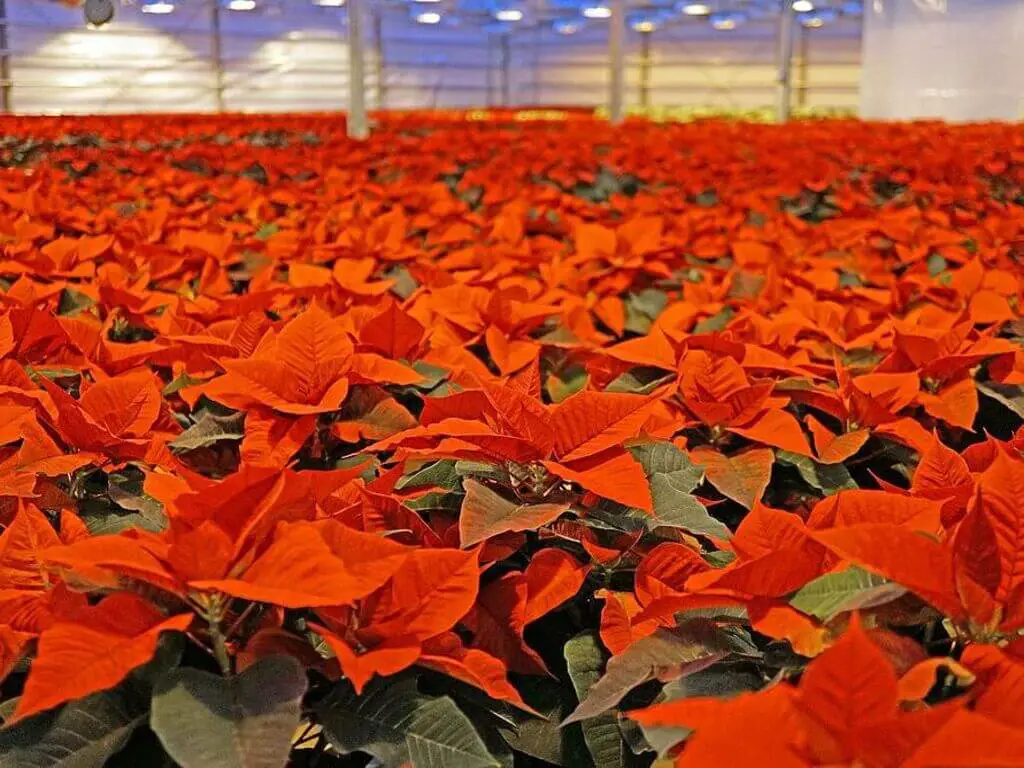
Photo by Tiia Monto (Wikimedia Commons) (CC BY-SA 4.0)
In 1900, Albert Ecke, a German national, migrated to Los Angeles. He ran a dairy and also an orchid farm in the well-known Eagle Rock area. He propagated poinsettia trees in his orchid and sold them commercially.
Paul Ecke, his son made use of grafting techniques to develop various cultivars. However, His grandson, Paul Ecke Jr was the reason behind the association of the poinsettia tree with Christmas in the commercial world.
He sent free poinsettias to television stations asking them to display it on air. He also promoted these trees by appearing in various television programs like Bob Hope’s Christmas specials and The Tonight Show.
In 1923, the Ecke family moved their business to Encinitas (California). Normally, the poinsettia tree has an open appearance. However, this family succeeded in developing a technique that gave a busy appearance to these trees. As a result, the sales of these trees skyrocketed. Thus, the Ecke family gained almost a virtual monopoly in the industry.
John Dole, a university researcher, “uncovered” this technique and published it in the late 1980s. After that, many nurseries develop similar trees and the competition grew stronger. As a result, the Ecke family stopped producing these trees.
However, as of 2008, this family met poinsettia market demands by 50% internationally and 70% domestically.
Description of Poinsettia Tree
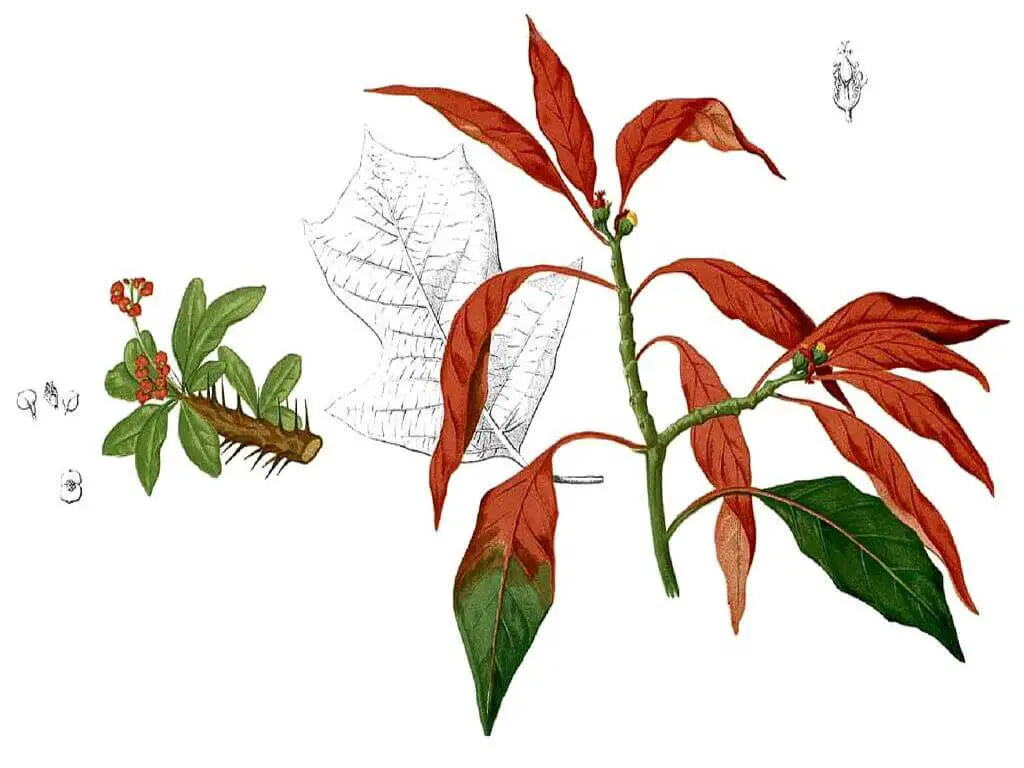
You can term poinsettia tree also as a shrub. Typically, it grows 2 – 13 feet (0.6–4 m) tall depending on the cultivar. The dark green leaves have dentate edges. They measure 2.8–6.3 inches (7 – 16 cm) in length.
The colored bracts are usually flaming red in color. They can also be white, cream, pale green, orange, or pink depending on the cultivar type. Due to their colorful nature, many people confuse these bracts with flowers. But they are leaves naturally.
In fact, a biological process called photoperiodism develops these beautiful colors in bracts. Normally, this process requires at least 14 hours of darkness every night consistently for about a couple of months. However, it also needs broad daylight to enhance the brightness of the color.
Generally, the flowers of this plant are grouped with cyathia (false flowers or yellow centers of leaf bunches). They do not attract pollinators. However, the pollination process, especially regarding wild poinsettia is still not studied completely. Some of the uncompleted studies indicate that some wasps and other insects do visit cyathia occasionally.
Propagation
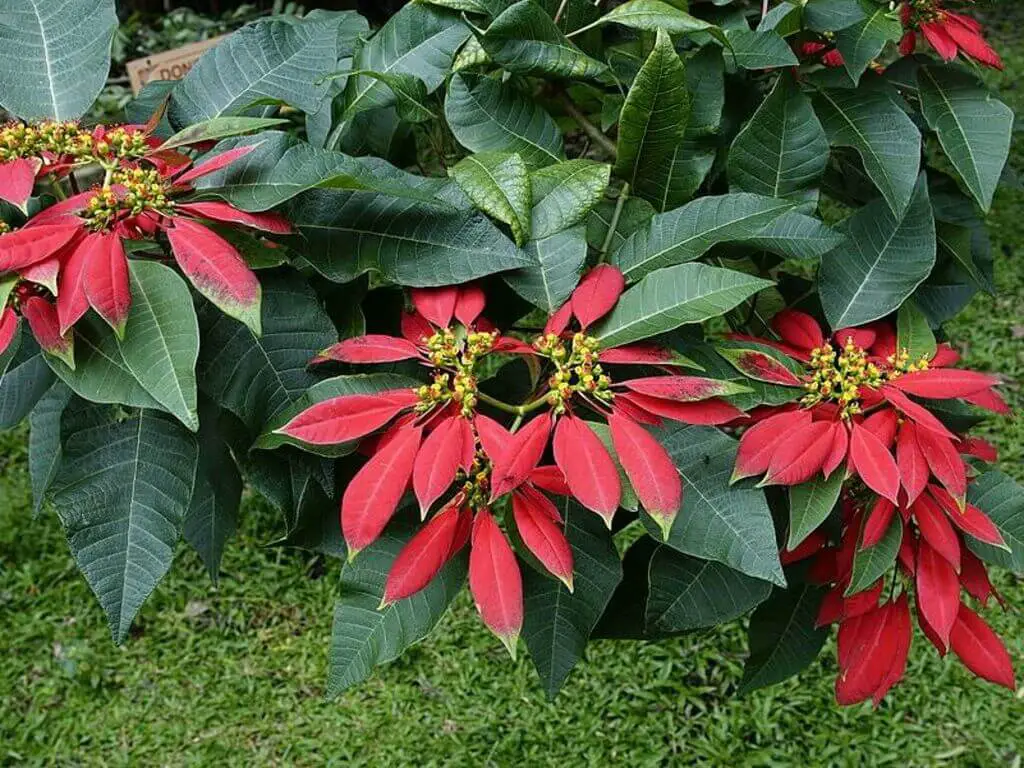
Photo by Vengolis (Wikimedia Commons) (CC BY-SA 4.0)
If you live in USDA Zones 10 or higher, you can grow poinsettia tree as a perennial. These plants prefer to grow in warm climates. You can directly plant them in the outdoor spaces. They grow well in the outdoor environment.
However, if you live in colder areas, you can grow them indoors as houseplants. They cannot tolerate the outdoor chilling temperatures.
Select a place that receives direct sunlight as well as some afternoon shades. Tilt and loosen the well-draining soil to a depth of about 30 – 40 cm (12 – 16 inches). Amend the resulting soil with a good quality organic compost.
Established Plants
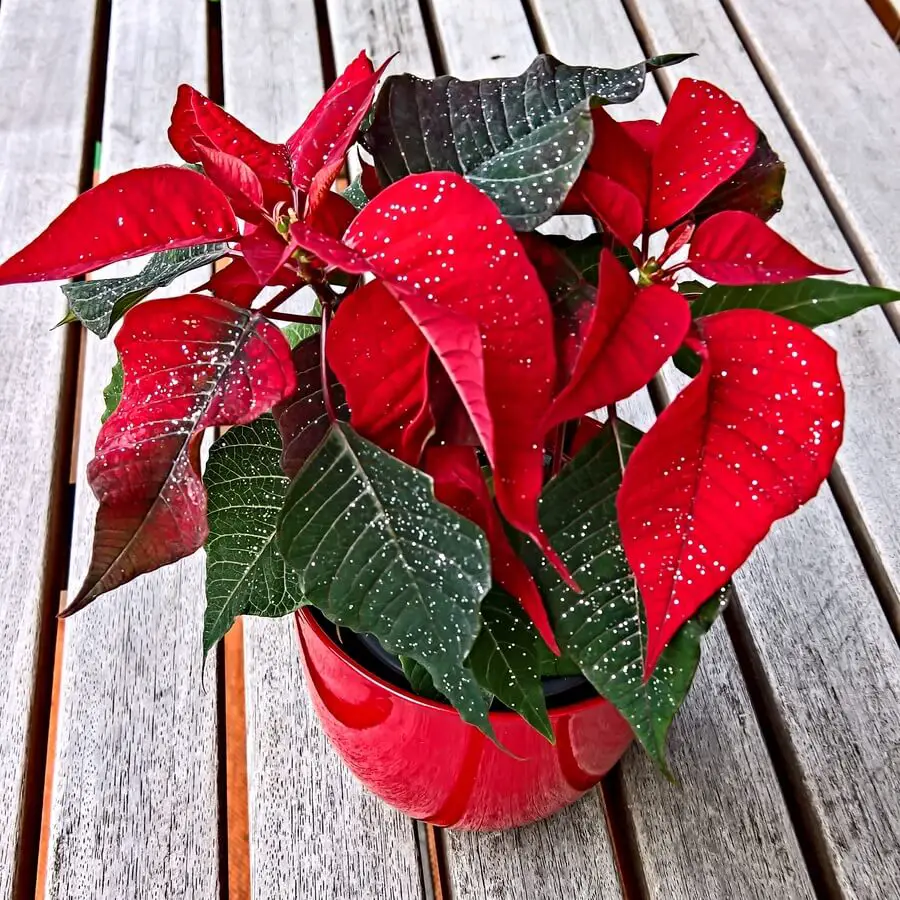
This is the easiest possible method to grow a poinsettia tree. You can purchase a poinsettia tree from online stores or garden nurseries, especially during Christmas.
After that, you can collect cuttings and seeds from this tree to grow additional poinsettias. We have elaborated on these procedures below.
1.) If you purchase the established plant during winter, keep the pot setting intact until spring. Make sure to remove wrappers so that the water can drain.
2.) Maintain the soil moisture by watering as needed.
3.) During the Spring (March – April), snip off the stems about 8 inches from the top. This helps fresh growth. You can use these cuttings for replanting.
4.) Apply a well-balanced fertilizer like NPK 12-12-12, at least once a month, until early summer.
5.) Start transplanting in summer. Dig a hole in the outdoor space, large enough to accommodate the root ball.
6.) Place the plant in an upright position and backfill the dug soil. Water thoroughly.
7.) Mulch the plant surrounding areas to 2 – 3 inches. This helps to retain moisture and maintains cool soil temperatures.
You can also grow them in pots if you live in cold regions. Just replant them in a larger container during summer. Make sure to add a good quality potting mix.
Place the container near a window so as to facilitate indirect sunlight. In summer, if the outdoor temperature stays consistently above 65 degrees Fahrenheit, you can place them outdoors too in a partially shaded area.
From Cuttings
Comparatively, this is also an easy method. Most gardeners use this method to propagate the poinsettia tree.
The propagation procedure is the same as stated above. However, we have elaborated the additional information below.
Always use clean garden shears to snip the cuttings.
Before planting, make sure to dip the cutting bottom portion in powdered rooting hormones. Then, plant them in pots filled with pasteurized potting soil.
Cover the pot set up with a large plastic bag. This encourages rooting by providing a mini greenhouse environment to the cuttings.
Water regularly. Once the cuttings are firmly rooted, transplant them to larger containers in summer as stated above.
From Seeds
You can purchase the seeds from online shops like amazon. You can also harvest them yourself from established plants.
When the foliage starts turning brown, you can collect the seed pods from the bracts. Then, dry them by placing them in a paper bag until they break open themselves. After that, you can collect the seeds from the broken pots.
Plant only one seed in every pot. Sow the seeds at least an inch deep into the soil. Keep the pot set up near a window so that it gets adequate indirect lighting. Water at regular intervals and maintain the soil moisture.
You can expect to see the seedlings with true leaves within a couple of weeks. After that, when the seedlings establish themselves by firmly rooting, you can transplant them in summer. The procedure is the same as stated above in this article.
Caring

During every growing season, amend the soil with a well-balanced fertilizer (NPK 12-12-12) or compost. If the soil quality is poor, you may need to amend it almost every month.
Water the poinsettia tree regularly. Maintain the soil moist but do not make the soil soggy. While watering, aim at the base of the poinsettia tree. Do not pour water vaguely over the foliage. These practices are essential to prevent common fungal diseases.
Throughout the growing season, snip off the small unhealthy shoots using good quality garden shears. This encourages blooming in poinsettias. You can also cut off the shoots and use them to grow more poinsettias. Prune again the old growth in late fall or winter. This encourages fresh growth, particularly during the following spring.
Remove the weeds by using a good quality weed remover. Mulch around the plant surroundings. This helps to check weed growth. It also helps to retain the soil warmth in winter.
If the soil temperature falls below 45 F (7 C), you may have to dig out the plant for overwintering indoors. So, it is advisable to grow poinsettias indoors in cold areas.
Pests and Diseases
Poinsettia tree is susceptible to some common pests and diseases. We have detailed the common troubles below.
Pests
Whiteflies
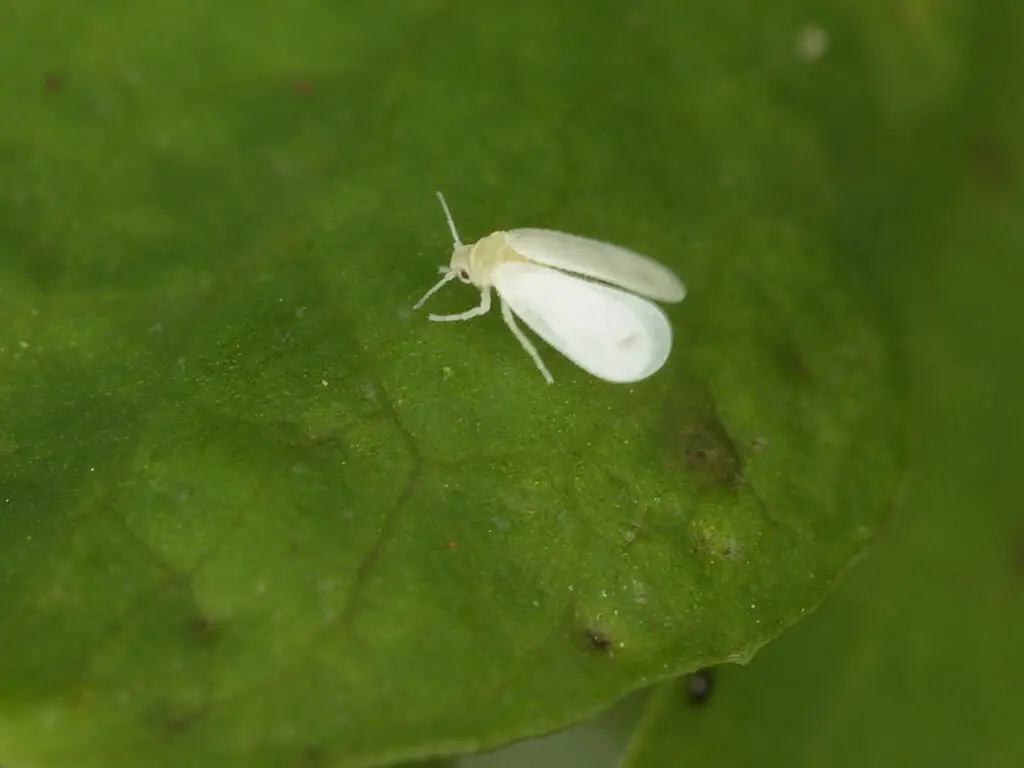
Photo by gbohne (Wikimedia Commons) (CC BY-SA 2.0)
Whiteflies are primary pests that affect these plants. They suck the plant fluids from the vascular system. They also excrete honeydew that attracts black sooty molds. You can treat these flies with Imidacloprid insecticide.
Fungus Gnats
The Fungus Gnat larvae feed on small roots and root hairs. This activity damages the plant’s ability to suck water from the ground and the plant dies finally. This fungus mostly attacks young plants and cuttings. You can treat this fungus effectively with neem oil.
Diseases
Bacterial Leaf spot

Generally, the bacterial Leaf spot infects plants in a wet, warm, and humid environment. Initially, the infected foliage develops water-soaked lesions. Then, these lesions progressively turn blackish, sometimes surrounded by yellow margins. Upon drying, the spots become brittle and crack.
There is no known cure for this disease. But you can prevent the disease. Keep the space debris free. Do not overwater. Facilitate airflow by pruning periodically.
Powdery Mildew
This is a common disease that affects plants in warm and dry environments. It covers the foliage with a gray or white powdery substance. In most cases, the infection starts from the underside of the leaves. Then, it spreads to upper leaves, buds, stem Etc.,
You can treat this disease with powdery mildew sprays that are formulated to treat this disease. Neem oil treatment is also proven to be effective. But if the infection is severe so as to weaken the whole plant, it is advisable to dispose of the plant as a whole.
Uses of Poinsettia Tree
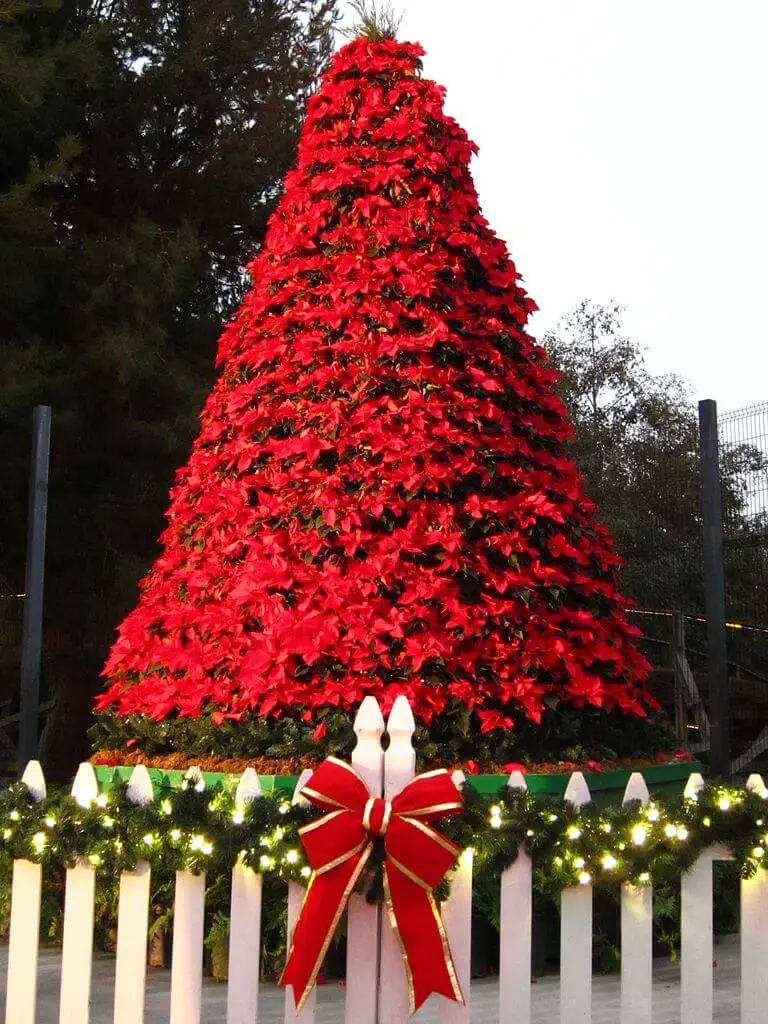
Photo by Steve D (Wikimedia Commons) (CC BY-SA 3.0)
In general, the poinsettia tree is used in several floral decorations, particularly during Christmas. It also serves as a “Christmas tree” during the Christmas celebrations. (Thanks to Paul Ecke Jr.). In fact, some people “paint” these trees to suit their color themes.
Poinsettias can also clean the air when you grow them indoors. The air from particle board, grocery bags, insulation, and some other household items contain formaldehyde. These plants can effectively remove formaldehyde from the air. Thus, these plants help in safeguarding human health too!
Some old consumers around the world use poinsettia and its latex (sap) as medicines.
These medicines are believed to stimulate the production of breast milk, facilitate abortion, and also treat general fever. Similarly, some people use poinsettia latex to remove skin hairs, heal skin disorders, and to treat warts.
However, these treatments are not scientifically proven and may have safety concerns. We recommend you consult a physician before trying these types of medicines.
Similar Posts
How to Grow Pansy Color Plants
How to Grow Matthiola Incana

